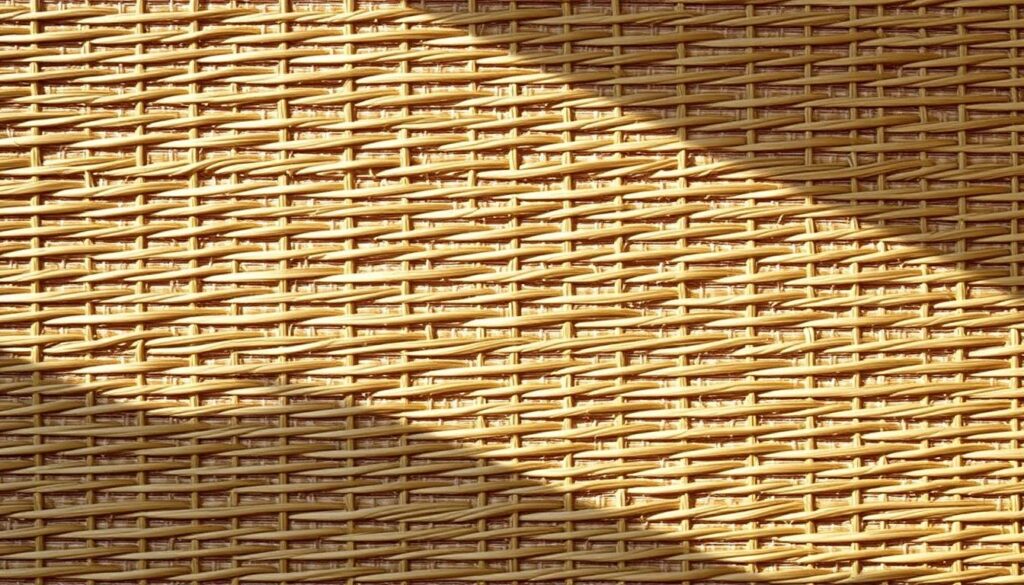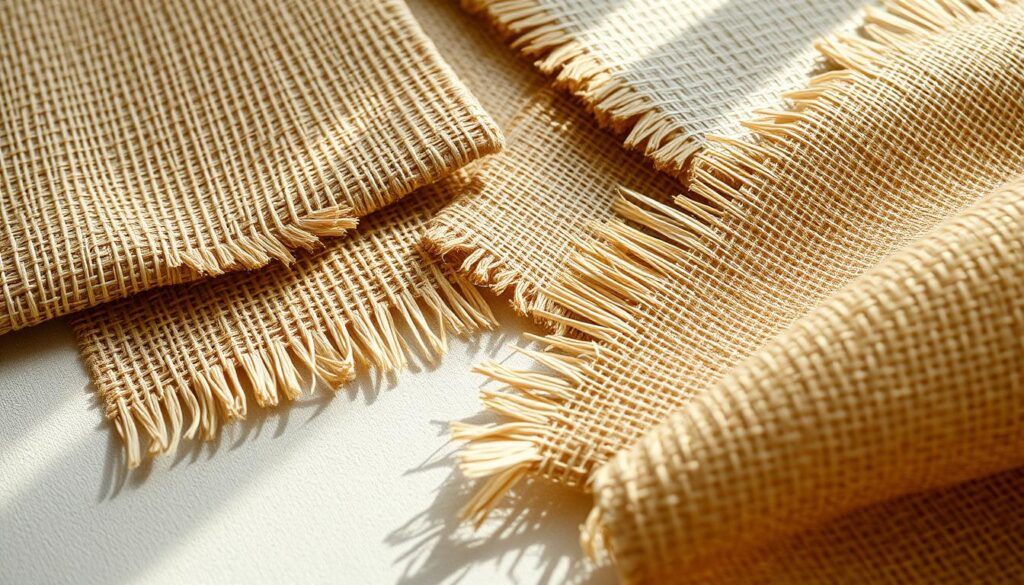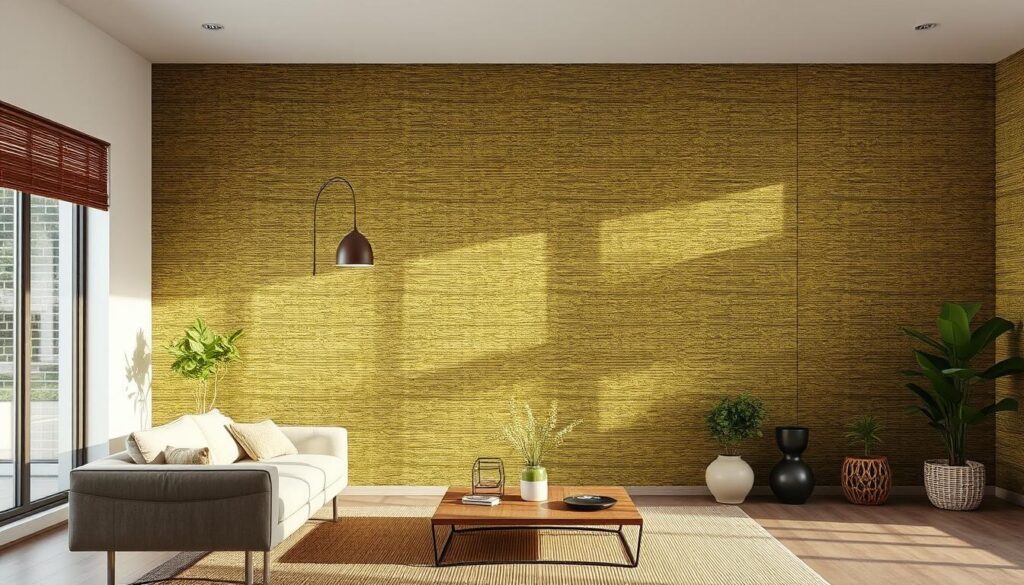Imagine walking into a serene and inviting space that feels connected to nature. Incorporating natural textures into your interior can transform your Grasscloth Home Design and create a warm, welcoming atmosphere.

One of the most effective ways to achieve this is by using Grasscloth Home Design in your interior spaces. This unique material brings a sense of organic elegance, adding depth and visual interest to your walls. With its versatility and aesthetic appeal, it’s no wonder that grasscloth is becoming a popular choice for those looking to elevate their interiors.
Key Takeaways
- Incorporating natural textures can enhance your home’s aesthetic appeal.
- Grasscloth adds an organic elegance to interior spaces.
- Using natural materials can create a warm and welcoming atmosphere.
- Grasscloth is versatile and can be used in various interior design settings.
- Elevate your interiors with unique and natural materials.
The Timeless Appeal of Grasscloth
Grasscloth has been a staple in interior design for centuries, offering a unique blend of natural beauty and sustainability. This material has captivated designers and homeowners with its organic texture and the warmth it brings to any room.
What Is Grasscloth?
Grasscloth is a type of wall covering made from natural fibers such as grass, reeds, or other plant materials. It’s known for its textured, earthy appearance and is often used to add depth and visual interest to rooms. The use of natural materials in grasscloth production not only enhances its aesthetic appeal but also contributes to its eco-friendly and sustainable characteristics.

A Brief History of Grasscloth in Interior Design
The history of grasscloth in interior design dates back centuries, originating in regions where natural fibers were abundant. Initially used for functional purposes, grasscloth evolved into a decorative element, valued for its unique texture and natural beauty. Over time, it has remained a popular choice due to its ability to bring warmth and a sense of organic elegance to spaces.
Some key points in the history of grasscloth include:
- Early use in traditional Asian and European interiors
- Revival in popularity during the 20th century as part of eco-friendly design movements
- Continued evolution with modern manufacturing techniques while maintaining traditional craftsmanship
Grasscloth’s timeless appeal lies in its ability to blend seamlessly with various design styles, from modern to traditional, and its contribution to creating sustainable living spaces.
Benefits of Incorporating Grasscloth Home Design
The use of grasscloth in interior design not only brings a touch of natural elegance but also offers several practical advantages. By incorporating grasscloth into your home, you can enhance both the aesthetic and functional qualities of your living spaces.
Natural Texture and Visual Depth
Grasscloth adds a unique natural texture to walls and other surfaces, creating visual depth and interest. This natural element can complement a variety of design styles, from modern to traditional, and can be used to create a focal point in any room. The organic texture of grasscloth also helps to add warmth and coziness to a space, making it feel more inviting.

Acoustic Properties and Sound Absorption
In addition to its aesthetic benefits, grasscloth also offers acoustic properties that can improve the overall ambiance of a room. The natural fibers in grasscloth can help absorb sound, reducing echo and creating a more peaceful environment. This makes grasscloth an excellent choice for home theaters, music rooms, or any space where sound quality is important.
Eco-Friendly and Sustainable Appeal
Grasscloth is made from eco-friendly and sustainable materials, making it an attractive option for environmentally conscious homeowners. The production process for grasscloth typically involves minimal environmental impact, and the materials used are often biodegradable and renewable. By choosing grasscloth, homeowners can enhance their living spaces while also supporting sustainable practices.
Types of Grasscloth Materials
From natural fibers to synthetic options, the types of grasscloth materials are as varied as they are versatile. Grasscloth has become a staple in interior design, offering a range of textures and aesthetics that can elevate any space.

Sisal and Jute Options
Sisal and jute are two of the most popular natural fibers used in grasscloth production. Sisal is known for its durability and coarse texture, making it ideal for high-traffic areas. Jute, on the other hand, is softer and has a more luxurious feel, often used in spaces where comfort is a priority.
- Sisal grasscloth is durable and resistant to wear.
- Jute grasscloth offers a softer, more luxurious texture.
Seagrass and Water Hyacinth Varieties
Seagrass and water hyacinth are other natural fibers used in grasscloth. Seagrass is highly durable and resistant to moisture, making it suitable for areas with high humidity. Water hyacinth, with its unique texture and pattern, adds a touch of exotic elegance to any room.
- Seagrass is durable and moisture-resistant.
- Water hyacinth adds an exotic touch to interiors.
Bamboo and Reed Alternatives
Bamboo and reed are eco-friendly alternatives used in grasscloth production. Bamboo is lightweight and sustainable, while reed is known for its flexibility and durability. Both materials offer a natural, earthy aesthetic that is increasingly popular in modern interior design.
- Bamboo is a sustainable and lightweight option.
- Reed is flexible and durable.
Synthetic Grasscloth Options
For those looking for a more affordable and versatile option, synthetic grasscloth is a viable alternative. Made from man-made fibers, synthetic grasscloth mimics the look and feel of natural fibers but often comes with added benefits such as stain resistance and easier maintenance.
Popular Rooms for Grasscloth Applications
Grasscloth is a versatile material that can elevate the aesthetic of various rooms in your home. Its natural texture and visual depth make it an excellent choice for those looking to add warmth and character to their living spaces.
Living Room Transformations
Grasscloth can transform your living room into a cozy, inviting space. Use it as an accent wall to create a focal point or cover entire walls to set the tone for the room. Pairing grasscloth with natural wood furniture and earthy tones can enhance the organic feel of the space.
Creating Serene Bedrooms
In bedrooms, grasscloth can contribute to a serene and calming atmosphere. It works well with soft lighting and natural textiles, creating a peaceful retreat. Consider using grasscloth on a single wall or as a headboard to add depth without overwhelming the space.
Home Office and Study Spaces
For home offices and study areas, grasscloth can add a touch of sophistication. It pairs well with modern furniture and can help create a productive environment. Using grasscloth on walls or even as a room divider can define the workspace.
Dining Rooms and Entertainment Areas
In dining rooms and entertainment areas, grasscloth can bring a sense of warmth and elegance. It’s particularly effective in rooms with natural stone or wood features, enhancing the overall aesthetic. Consider using it on a feature wall or as part of a larger design scheme.
| Room | Grasscloth Application | Design Tips |
|---|---|---|
| Living Room | Accent wall or full wall coverage | Pair with natural wood furniture |
| Bedroom | Single wall or headboard | Combine with soft lighting and natural textiles |
| Home Office | Walls or room divider | Pair with modern furniture for a sophisticated look |
| Dining Room | Feature wall | Enhance with natural stone or wood features |
Grasscloth Home Design: Creative Applications
Grasscloth is not just a material, it’s a way to bring the outdoors into your home, enhancing the ambiance of any room. Its versatility allows it to be used in various creative ways, from wall coverings to furniture facing, and even ceiling applications.
Wall Coverings and Accent Walls
One of the most popular uses of grasscloth is for wall coverings and accent walls. It adds a natural texture and visual depth to rooms, creating a unique focal point. Grasscloth can be used to cover entire walls or just a single accent wall, depending on the desired impact.
Full Room vs. Feature Wall Approaches
When deciding how to incorporate grasscloth into your wall design, consider whether you want to cover an entire room or create a feature wall. A full-room approach can create a cohesive, immersive environment, while a feature wall can add a striking accent without overwhelming the space.
Furniture and Cabinet Facing
Beyond wall coverings, grasscloth can also be used to face furniture and cabinets, adding a touch of natural elegance to your decor. This technique can transform ordinary pieces into statement items, blending seamlessly with various design styles.
- Unique Texture: Adds a tactile element to furniture.
- Versatility: Can be used on a variety of furniture pieces, from cabinets to headboards.
- Eco-Friendly: Maintains the sustainable appeal of grasscloth.
Ceiling Applications and Room Dividers
Grasscloth can also be used in more unconventional ways, such as ceiling applications and room dividers. These uses can add an extra layer of texture and interest to a room, helping to define different spaces within an open-plan area.
By incorporating grasscloth into your home design through these creative applications, you can achieve a unique and inviting atmosphere that reflects your personal style.
Color Palettes and Design Styles
The natural beauty of grasscloth allows it to seamlessly blend with a multitude of design aesthetics and color schemes. This versatility makes it an ideal choice for homeowners looking to create a unique and personalized space.
Coastal and Beach-Inspired Designs
Grasscloth is a perfect fit for coastal and beach-inspired designs, where its natural texture and earthy tones complement the relaxed, airy feel of these styles. Soft blues, sandy neutrals, and seafoam greens are popular color palettes that work well with grasscloth. To enhance the coastal vibe, consider pairing grasscloth with natural elements like driftwood or woven sea grass.
Modern and Contemporary Applications
In modern and contemporary settings, grasscloth can add warmth and depth to otherwise minimalist spaces. Neutral color palettes with bold accents can create a striking contrast with the natural texture of grasscloth. For a sleek, modern look, pair grasscloth with metallic accents or monochromatic color schemes.
Traditional and Transitional Spaces
Grasscloth can also be incorporated into traditional and transitional spaces, where its classic, timeless appeal complements rich wood tones and ornate furnishings. Earthy color palettes with warm, muted tones can create a cozy, inviting atmosphere. As
“Grasscloth brings a sense of organic elegance to traditional interiors, grounding the space with its natural beauty.”
Bohemian and Global-Inspired Interiors
For bohemian and global-inspired interiors, grasscloth offers a versatile canvas for eclectic, layered decor. Vibrant color palettes and diverse textures can be combined with grasscloth to create a rich, visually interesting space. To enhance the bohemian vibe, layer grasscloth with other natural textures like woven baskets or vintage textiles.
Installation Considerations and Tips
A successful grasscloth installation hinges on proper preparation, the right techniques, and an understanding of the material’s unique characteristics. Whether you’re a seasoned DIY enthusiast or a homeowner looking to hire a professional, knowing what to expect can make all the difference.
DIY vs. Professional Installation
Deciding between a DIY installation and hiring a professional depends on your comfort level with the process and the complexity of your space. DIY installation can be cost-effective and rewarding, but it requires careful measurement, cutting, and application to avoid mistakes. On the other hand, professional installers bring experience and expertise, ensuring a flawless finish, especially in challenging areas like corners and around obstacles.
Preparing Your Space
Before installing grasscloth, it’s crucial to prepare your space adequately. This involves clearing the room of furniture and coverings, ensuring the walls are clean, dry, and free of old adhesive. Proper preparation also includes checking for any necessary repairs to the walls and having the right tools and materials ready. Taking these steps helps ensure a smooth installation process.
Working Around Obstacles and Corners
One of the more challenging aspects of grasscloth installation is working around obstacles and corners. To achieve a professional finish, it’s essential to measure carefully and plan your cuts in advance. Using the right tools, such as a sharp utility knife and a straightedge, can help you navigate tricky areas. Additionally, applying grasscloth in sections can make it easier to manage around electrical outlets, windows, and other obstacles.
Maintaining and Caring for Grasscloth
The unique characteristics of grasscloth demand a thoughtful approach to maintenance and care. To preserve its natural beauty and extend its lifespan, it’s crucial to understand the best practices for cleaning, repairing, and maintaining grasscloth surfaces in your home.
Cleaning Techniques and Regular Maintenance
Regular dusting is essential to prevent the buildup of dirt and debris on grasscloth surfaces. Use a soft-bristled brush or a dry cloth to gently remove dust. For more thorough cleaning, a slightly damp cloth can be used, but be sure to test a small, inconspicuous area first to ensure the material can withstand moisture.
Addressing Damage and Repairs
Despite proper care, grasscloth can sometimes suffer damage. Minor tears or fraying can often be addressed with simple repair techniques, such as trimming loose fibers or applying a fabric adhesive. For more significant damage, consider consulting a professional.
Longevity and Replacement Considerations
The longevity of grasscloth depends on various factors, including the quality of the material, the amount of wear it receives, and how well it is maintained. On average, well-cared-for grasscloth can last for many years. The following table outlines the average lifespan of different types of grasscloth:
| Type of Grasscloth | Average Lifespan |
|---|---|
| Sisal | 5-7 years |
| Jute | 3-5 years |
| Seagrass | 7-10 years |
By understanding these factors and taking proactive steps in maintenance and care, you can enjoy the natural elegance of grasscloth in your home for years to come.
Seasonal Trends and Styling with Existing Decor
With the arrival of each new season, homeowners look for ways to update their interiors, and grasscloth offers a natural, stylish solution. Incorporating grasscloth into your home decor can be a great way to refresh your space and keep it looking its best throughout the year. This natural material can be seamlessly integrated into various design styles, making it an ideal choice for those looking to update their decor seasonally.
Complementing Different Wood Tones
Grasscloth can complement a variety of wood tones, from light oak to dark walnut. For a cohesive look, choose a grasscloth that either matches or contrasts with the wood tones in your furniture and flooring. For instance, a light grasscloth can brighten up a room with dark wood accents, creating a beautiful contrast. Conversely, a darker grasscloth can add warmth to a room with light wood tones.
Pairing with Textiles and Soft Furnishings
Pairing grasscloth with textiles and soft furnishings is another effective way to style your space. Consider combining grasscloth walls with linen curtains, wool throw blankets, or velvet upholstered furniture. The natural texture of grasscloth pairs well with a variety of fabrics, adding depth and visual interest to your rooms. For a cohesive look, select textiles that share a similar color palette or texture with your grasscloth.
Lighting Considerations for Grasscloth Spaces
Lighting can significantly impact the appearance of grasscloth. To highlight its natural texture, use warm, soft lighting. Table lamps or floor lamps with natural linen shades can complement grasscloth nicely. Additionally, consider using LED strip lighting or backlighting to create a unique ambiance. The right lighting can enhance the beauty of grasscloth, making it a stunning focal point in any room.
Conclusion: Embracing Natural Elegance in Your Home
As we’ve explored throughout this article, grasscloth home design offers a unique blend of natural elegance and versatility, making it an ideal choice for those seeking to elevate their interiors. By incorporating grasscloth into your home decor, you can add texture, depth, and a touch of organic sophistication to any room.
The benefits of grasscloth extend beyond its aesthetic appeal, providing acoustic properties, eco-friendly sustainability, and a range of creative applications. Whether you’re looking to create a serene bedroom, a modern living room, or a cozy home office, grasscloth can be tailored to suit your design style and preferences.
By embracing grasscloth in your home decor, you can bring a sense of natural elegance into your living spaces, creating a warm and inviting atmosphere that reflects your personal taste. With its numerous benefits and design possibilities, grasscloth is an excellent choice for homeowners seeking to enhance their interiors with a unique and sustainable material.
FAQ
What is grasscloth, and how is it made?
Grasscloth is a natural wall covering made from woven fibers such as sisal, jute, or seagrass. It’s typically made by hand, using traditional techniques to create a unique, textured surface.
Is grasscloth suitable for all rooms in my home?
Grasscloth can be used in various rooms, including living rooms, bedrooms, and home offices. However, it’s not recommended for high-moisture areas like bathrooms or kitchens, as it can be damaged by excessive humidity.
How do I clean and maintain my grasscloth wall covering?
To clean grasscloth, gently vacuum the surface using a soft-bristled brush attachment. For tougher stains, use a damp cloth to blot the area, avoiding harsh chemicals or excessive moisture.
Can I install grasscloth myself, or do I need a professional?
While it’s possible to install grasscloth yourself, it’s recommended to hire a professional for a seamless, high-quality finish. Professionals have the necessary experience and skills to handle any challenges that may arise during installation.
How long does grasscloth typically last, and when should it be replaced?
The lifespan of grasscloth depends on various factors, including the quality of the material, installation, and maintenance. On average, grasscloth can last for 10 to 15 years or more with proper care. It may need to be replaced if it becomes damaged or shows significant signs of wear.
Can grasscloth be used on ceilings or just walls?
Grasscloth can be used on both walls and ceilings, adding a unique, natural element to your space. However, ceiling installation may require additional support and specialized techniques.
Is grasscloth eco-friendly and sustainable?
Yes, grasscloth is considered an eco-friendly and sustainable option for wall coverings. It’s made from natural, renewable materials and is biodegradable, making it a great choice for those looking to reduce their environmental impact.
Can I paint or stain my grasscloth to match my existing decor?
While some grasscloth products can be painted or stained, it’s not always recommended, as it may affect the material’s texture and appearance. It’s best to consult with a professional or the manufacturer’s guidelines before attempting to alter the color or finish of your grasscloth.

